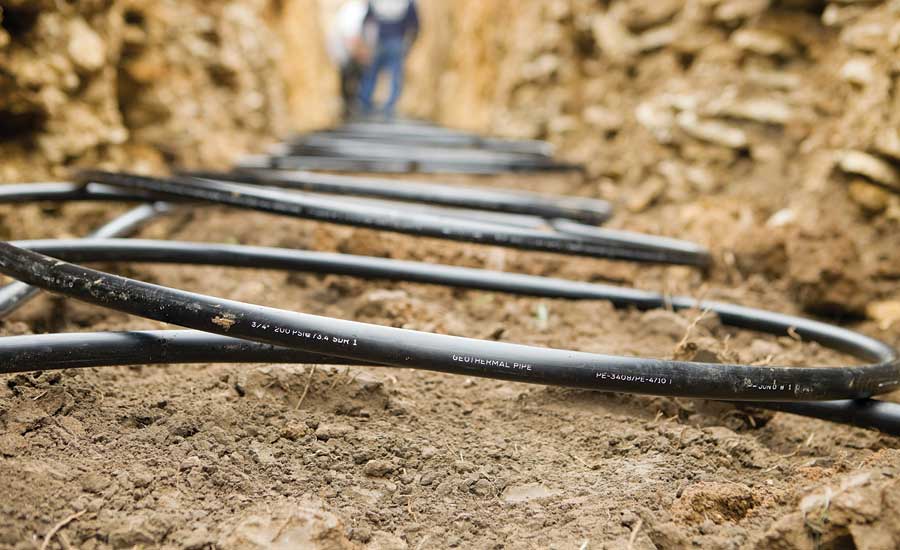The end of 2016 also witnessed the end of eight years of tax credits that subsidized commercial and residential geothermal installations across the U.S. While the change had been coming for some time, the geothermal industry maintains it is being disproportionally harmed by the end of the credits after the 114th Congress in 2016 extended similar credits for other renewable technologies such as wind and solar while leaving out geothermal entirely.
The result, said Geothermal Exchange Organization President and CEO Doug Dougherty, is an unfair situation that puts geothermal manufacturers and contractors at a disadvantage through 2021.
“We are trying to level the playing field,” Dougherty said. “Our message is, ‘Hey, you’re using a tax code to pick renewable winners and losers, and that’s not what you should be doing.’ They picked specific renewable technologies out of specific paragraphs and left the others behind, clearly picking winners and losers.”
Calling for fairness
Numerous efforts from GEO and others to include extensions to the geothermal tax credits in various pieces of legislation for more than a year now have all come up short, though the organization is placing renewed hope in H.R. 1090 — the bipartisan Technologies for Energy Security Act of 2017 reintroduced in February by U.S. Reps Tom Reed (R-N.Y.), and Mike Thompson (D-Calif.). Together with other clean energy technology advocates, GEO hopes the bill will put geothermal technologies back on par with its renewable counterparts.
According to Dougherty, the bill would reinstitute and extend through 2021 commercial and residential installation tax credits for geothermal heat pumps, fuel cells, microturbines, small wind, and combined heat and power. For residential applications, that includes a retroactive Income Tax Credit, under Section 25D, of 30% that phases out in steps before ending Dec. 31, 2021. The commercial tax credit, under Section 48, will remain at 10% through 2021. The bill also changes “placed in service” language in the tax code to “construction of which begins before Jan. 1, 2022,” for commercial projects, which alleviates the issues caused when project completion timelines are unsure.
“The growing number of cosponsors from coast to coast for the bill highlights that geothermal heat pumps are indeed a 50-state technology,” Dougherty said. “Our congressional supporters recognize that with thousands of jobs in the geothermal heat pump and other orphaned clean energy industries on the line, urgent action is needed.”
In a February press release, Reed added: “We care about ensuring that we can produce reliable, clean and affordable energy that our nation needs right here at home. By implementing common-sense policies like this one, we can ensure that this can be accomplished. As we move forward with tax reform, having a structure that encourages this kind of development creates the quality, family-sustaining jobs that people throughout our country deserve, all while helping meet the energy demands of today and tomorrow. It’s a win-win.”
An uphill battle
Steve Smith, president and CEO of Enertech Global, said geothermal manufacturers and contractors began seeing a drop-off in new projects nearly a year ago as the tax credits neared expiration.
“With new construction, that process is planned out well in advance, so what we noticed was that, earlier in 2016, the projects that we would be working on for quoting, estimating and helping to design were starting to slow down,” Smith said. “We were getting feedback from our territory managers out there across the country that, especially in bigger homes, were dropping off and deciding against geothermal because they would not be done or even under roof by Dec. 31, 2016.”
Smith said commercial projects also dropped off early in 2016, though, as the end of the credits became increasingly apparent, Enertech experienced a “boom” in November and December.
“It brought on, to me, an artificial bubble that did burst come Jan. 1, 2017,” he said. “Normally, the orders slow down some in January, but they really, really slowed down this year. We were down in the 30-35% range, year-over-year, in just the first three weeks of January. We estimated 30-40%, and I’m sorry to say we’ve been accurate so far.”
Smith said they are already changing their business strategy and plan to focus more on commercial projects as well as retrofit opportunities, both commercial and residential, as the first wave of geothermal units installed decades ago continue to age out.
Smith said Enertech is looking into other technologies, including air-to-water heat pumps, in order to accommodate a changing geothermal landscape, especially if the tax credits are not renewed soon.
Efforts from the Geothermal Exchange Organization to include extensions to the geothermal tax credits for more than a year have come up short. The GEO, is placing renewed hope in H.R. 1090 — the bipartisan Technologies for Energy Security Act of 2017.
“Right now, we’re not looking at conventional mini-splits or conventional HVAC simply because that field is so big and has so many players,” he said. “We want to develop our own path, our own route, and not be a ‘me, too.’ It’s going to be a difficult task. We’re going to have to look at things differently and do things differently in how we go to market.”
Potential solutions
With Rep. Reed’s bill, Dougherty said the geothermal industry is optimistic that the credits — and market fairness — will be retroactively restored. However, two hurdles remain.
“One is to get Congress to act” on the bill, he said. “The other is to get [President] Donald Trump to sign it.”
The bill’s bipartisan support — dozens of representatives have signed onto it from both sides of the aisle — is a sign the bill has a chance of passing, though only time will tell.
“Trump has geothermal in some of his buildings, and his daughter is very pro-renewable-energy — she gets it. Some of his appointees, they don’t get it,” Dougherty said. “There are so many ironies. Texas is the biggest wind state in the country, and much of it was put up when [Energy Secretary] Rick Perry was governor. And [EPA Administrator Scott] Pruitt comes from Oklahoma, which is the geothermal heat-pump center of the universe. The biggest small wind manufacturer is also in Oklahoma. Even though Pruitt is more anti-EPA-regulations than anti-renewable-energy, I know that he knows that geothermal heat pumps are a big deal in Oklahoma.”
Still, there is concern that damage may have already been done to the general public’s perception of geothermal as a renewable technology.
“Many contractors and subcontractors are concerned not so much that the benefits of geothermal have been diminished any, but when you lose a tax credit, you lose, really, a perceived credibility,” Smith said. “People say, ‘Hey, they kept solar and wind going, so I guess geothermal wasn’t good enough.’”
Fixing that disparity is only fair, Dougherty said.
“Put us on par with them — that’s what we continue to say till we’re blue in the face. We think that if we can get congressional action, the Trump administration isn’t going to balk at this.”





